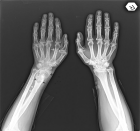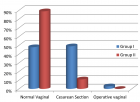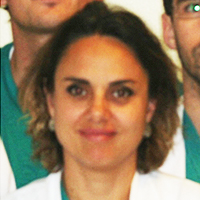Table of Contents
Nasopalatin duct cysts: Report of ten cases and review of literature
Published on: 10th November, 2020
OCLC Number/Unique Identifier: 8872658282
Nasopalatine duct cyst is the most common non-odontogenic cyst. It develops in the midline of the anterior maxilla. It is usually asymptomatic and sometimes it can be overlooked or misdiagnosed. We present 10 patients who applied to Istanbul Universi... ty Faculty of Dentistry, Department of Oral and Maxillofacial Surgery. Show more >
A comparison of complications associated with nutrition between the patients receiving enteral or parenteral in the intensive care unit
Published on: 29th September, 2020
OCLC Number/Unique Identifier: 8872656709
The aim of this study was to investigate and compare the complications including infection and mortality associated with enteral and parenteral nutrition on patients in the ICU of a university hospital.
In this study, a total of 100 patients who were... under follow-up in the ICU for two years were examined. In our study, demographic characteristics, the reason for admission, comorbidity, initial ICU laboratory values, morbidity and mortality during the follow-up period of the patients who only received enteral nutrition (EN) or parenteral nutrition (PN) were evaluated, and the results between two were compared as well as evaluating the complications within the groups.
The comparison of the reason for admission between the EN and PN groups showed that surgical reasons were significantly higher in the PN group. Nosocomial infections, the presence of infection and the development of sepsis were significantly higher in the EN group. The 28-day mortality rate was higher in the PN group compared to the EN group. The length of stay in the ICU and on mechanical ventilation was longer in the EN group. There was no significant difference in the 28-day mortality, readmission to the ICU and repeated endotracheal intubation between the two groups.
Because there is no statistical difference between EN and PN groups in point of infection and mortality, we conclude that the length of stay in the ICU and reason for admission play a more crucial role in the development of infection and on mortality rather than enteral or parenteral nutrition route. Show more >
The choice of optimal modern muscle relaxants (rocuronium bromide, atracurium besilate and cisatracurius besilate) in one-day surgery in children
Published on: 15th June, 2020
OCLC Number/Unique Identifier: 8633140096
The choice of the optimal muscle relaxant in one-day surgery in children with “small” surgical interventions remains relevant to this day. In modern pediatric surgery, the requirements for the quality of muscle relaxation are highest. However, along ... with the effectiveness of the drug, its duration and controllability of the action, as well as the safety of use, are important [1-7].
The aim of the study: To determine the pharmacoeconomic rationale for the rational use of muscle relaxants, depending on the duration of operations in one-day surgery in children.
Material and research methods: The study was conducted in surgical clinics of the Azerbaijan Medical University. The study included 156 children who were operated on routinely from 0 to 16 years old (risk of anesthesia I-II ASA), who used combined endotracheal anesthesia during surgery. Based on the requirements of the GCP international program (Good Clinical Practice), the inclusion of children in the study was carried out only after the written consent of the parents. The studied patients were divided into 3 groups depending on the muscle relaxant used: IA (n = 52) - rocuronium bromide (esmeron), IB (n = 52) - atracurium besilate (tracrium), IC (n = 52) - cisatracurius besilate (nimbex). Depending on the type of general anesthesia, these groups were also divided into 2 subgroups: anesthesia based on isoflurane + fentanyl ″ + iso ″ and anesthesia based on sevoflurane + fentanyl ″ + sev ″. The main groups were also divided into 2 age subgroups: children under 2 years of age – IA1, IB1, IC1 and children from 2 to 16 years old – IA2, IB2, IC2. Show more >
Anaesthetic management of an elderly patient with ischaemic heart disease and previous MI undergoing elective inguinal hernia repair: Case report
Published on: 25th May, 2020
OCLC Number/Unique Identifier: 8615126196
Ischemic heart disease may occur in isolation, or in combination with the pathological process of vascular ageing, arteriosclerosis. These two conditions have differing impacts on the haemodynamic changes in response to anaesthesia and surgery. Hyper... tension is not a feature of ischemic heart disease, and vice versa, but where the two conditions co-exist, hypertension aggravates and accelerates the pathological processes of ischemic heart disease. Patients older than 40 yrs. presenting for anaesthesia and surgery must therefore be considered at risk of any combination of these three conditions. Anaesthetic techniques must also be chosen to minimize haemodynamic changes which in the normal healthy patient cause no serious morbidity, but which, in the patient with ischemic heart disease, can lead to serious morbidity or death. Here we report a 70 years old (BMI of 23.3) elderly, hypertensive Male patient with ischemic heart disease with previous MI (EF of 40% - 5%) undergoing elective Inguinal hernia repair. We Opted Spinal anesthesia over General anaesthesia as it should be an asset in cardiac patients undergoing non-cardiac lower abdominal surgeries to reduce preload and after load, stress response, coagulation responses, improves coronary perfusion, provides better postoperative analgesia, reduces incidence of perioperative MI, maintains myocardial oxygen supply demand ratio and avoids harmful effects of GA such as hypotention due to intravenous induction drugs, tachycardia and hypertension due to pressor response during direct laryngoscopy and tracheal intubation. Show more >

HSPI: We're glad you're here. Please click "create a new Query" if you are a new visitor to our website and need further information from us.
If you are already a member of our network and need to keep track of any developments regarding a question you have already submitted, click "take me to my Query."
























































































































































